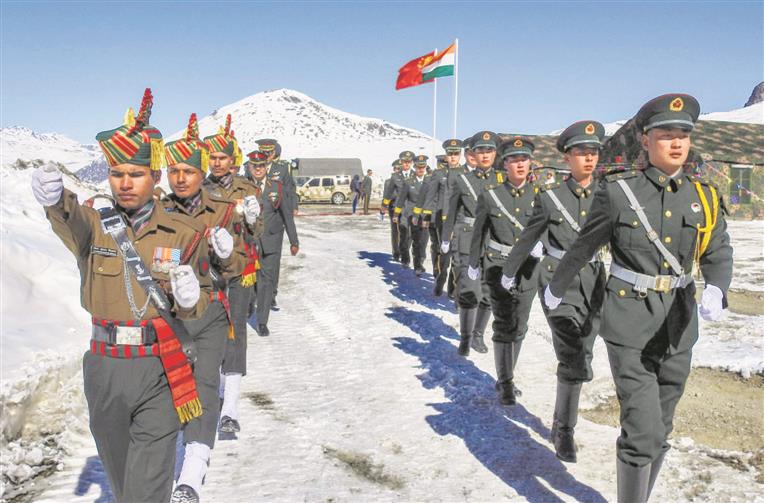
The talks came a day ahead of Lieutenant General-level dialogue between Indian and Chinese armies to resolve the month-long standoff in eastern Ladakh.
New Delhi, June 5
In the midst of their massive military standoff in eastern Ladakh, India and China on Friday vowed not allow their "differences" become disputes and agreed to handle them through talks while respecting each other's sensitivities, concerns and aspirations.
The positive approach by the two countries in addressing strain in ties came at a video conference between Naveen Srivastava, Joint secretary (East Asia) in the external affairs ministry and Wu Jianghao, director general in China's foreign ministry.
The talks came a day ahead of Lieutenant General-level dialogue between Indian and Chinese armies to resolve the month-long standoff in eastern Ladakh.
Without directly referring to the military standoff, the External Affairs Ministry said the two sides reviewed the state of bilateral relations including the "current developments".
"In this context they recalled the consensus reached by the leaders of the two countries, that peaceful, stable and balanced relations between India and China will be a positive factor for stability in the current global situation," the MEA said in a statement.
It further said: "Both sides agreed that in accordance with the guidance provided by the leadership, the two sides should handle their differences through peaceful discussion bearing in mind the importance of respecting each other's sensitivities, concerns and aspirations and not allow them to become disputes." The MEA said two sides agreed to settle differences in accordance with guidance provided by leadership of two countries, in a reference to decisions taken by Prime Minister Narendra Modi and Chinese President Xi Jinping in their first informal summit in Chinese port city of Wuhan in 2018.
In Beijing, the Chinese Foreign Ministry said the two countries should not pose a "threat" to each other and not let their differences turn into disputes while underlining the need for managing differences properly.
The MEA said the two sides also exchanged views on the challenge posed by the COVID-19 pandemic and cooperation in various multilateral forums.
The Indian and Chinese troops have been locked in a bitter military standoff in at least four sensitive areas in Eastern Ladakh following an incident of violent clashes between then in Pangong Tso on May 5 and 6.
The two sides resorted to massive build up and have been on an eyeball-to-eyeball situation in Galwan Valley, Pangong Tso, Demchok and Daulat Beg Oldi.
On Saturday's military talks, official sources said the Indian delegation will press for restoration of status quo ante all areas of eastern Ladakh, oppose huge build up of Chinese troops in the region and ask China not to resist infrastructure development by India on its side of the de-facto border.
The Indian delegation will be led by Lt General Harinder Singh, the general officer commanding of Leh-based 14 Corps, while the Chinese side will be headed by the Commander of the Tibet Military District, they said.
In their first informal summit in 2018, Modi and Xi had decided to issue "strategic guidance" to their militaries to strengthen communication and build trust and understanding between the border guarding forces of the two countries. The summit had taken place months after Indian and Chinese troops were locked in a 73-day-long standoff in Doklam.
When asked about the Lt General-level dialogue, a Chinese Foreign Ministry spokesman told a media briefing in Beijing: "We have full-fledged border-related mechanisms and we maintain close communications though military and diplomatic channels." The sources said India was not expecting any "concrete outcome" from the meeting, but considers it important as the high-level military dialogue could pave the way for a negotiated settlement of the tense standoff.
After the standoff began in early last month, Indian military leadership decided that Indian troops will adopt a firm approach in dealing with the aggressive posturing by the Chinese troops in all disputed areas of Pangong Tso, Galwan Valley, Demchok and Daulat Beg Oldie.
The Chinese army is learnt to have deployed around 2,500 troops in Pangong Tso and Galwan Valley besides gradually enhancing temporary infrastructure and weaponry.
The sources said satellite images have captured significant ramping up of defence infrastructure by China on its side of the LAC, the de-facto border, including by upgrading a military airbase around 180 km from the Pangong Tso area.
The Chinese Army has been gradually ramping up its strategic reserves in its rear bases near the the LAC by rushing in artillery guns, infantry combat vehicles and heavy military equipment, the sources said.
China has also enhanced its presence in certain areas along the Line of Actual Control in Northern Sikkim and Uttarakhand following which India has also been its presence by sending additional troops, they said.
Meanwhile, sources said the intelligence agencies have submitted a detailed to the government on the overall situation in eastern Ladakh and how Chinese military has increasingly strengthened its positions in Pangong Tso, Galwan Valley, Daulat Beg Oldie and Demchok.
The trigger for the face-off was China's stiff opposition to India laying a key road in the Finger area around the Pangong Tso Lake besides construction of another road connecting the Darbuk-Shayok-Daulat Beg Oldie road in Galwan Valley.
The road in the Finger area in Pangong Tso is considered crucial for India to carry out patrol. India has already decided not to stall any border infrastructure projects in eastern Ladakh in view of Chinese protests.
Government sources said military reinforcements including troops, vehicles and artillery guns were sent to eastern Ladakh by the Indian Army to shore up its presence in the areas where Chinese soldiers were resorting to aggressive posturing. The India-China border dispute covers the 3,488-km-long LAC. China claims Arunachal Pradesh as part of southern Tibet while India contests it. Both sides have been asserting that pending the final resolution of the boundary issue, it is necessary to maintain peace and tranquillity in the border areas. PTI
Join Whatsapp Channel of The Tribune for latest updates.



























